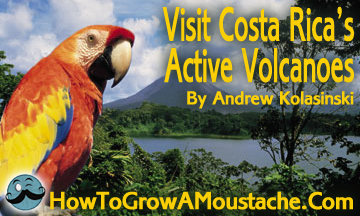Staring into the solid wall of white cloud, I tried to envision what my guide, Emmanuel had described. On a clear day, he said, we could easily see the crater and the geyser of Poas Volcano, along with both The Pacific and Atlantic coasts. But clouds are a fact of life on volcanic mountaintops and sometimes the view refuses to present itself.
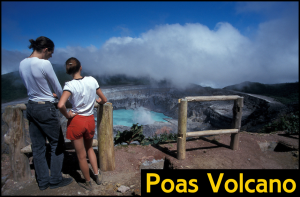 It was still worthwhile. The volcano trails were rich with Poor Man’s Umbrellas and other unique plants and flowers. Emmanuel capped the day by taking us to Escalonia Trail to see rare pyramid shaped Escalonia Trees as well as hummingbirds and the elusive Poás Squirrel.
It was still worthwhile. The volcano trails were rich with Poor Man’s Umbrellas and other unique plants and flowers. Emmanuel capped the day by taking us to Escalonia Trail to see rare pyramid shaped Escalonia Trees as well as hummingbirds and the elusive Poás Squirrel.
The hike to the crater rim was bracing: buffeted by winds and splattered with rain in contrast to the tropical warmth at the valley’s bottom. Luckily Emmanuel provided everyone on the tour with proper rain gear.
Costa Rica’s mountain spine is a part of the Pacific Rim of Fire. The small country has a dozen active volcanoes. While these pose a hazard to the people they are also a wild spectacle that attracts visitors from around the world to fill the coffers of this tourist industry nation.
There are half a dozen volcanoes that have erupted in the last century, and another half dozen that are considered active. Most of these are located in sparsely populated and difficult to reach areas that are seldom visited by tourists.
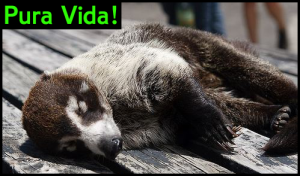 Volcan Poás is by far the most popular, and among the more active. In the last two centuries Poás has spewed lava 39 times. It is only 40 kilometers from San Jose and the most accessible volcano.
Volcan Poás is by far the most popular, and among the more active. In the last two centuries Poás has spewed lava 39 times. It is only 40 kilometers from San Jose and the most accessible volcano.
Poás’summit is 8,900 feet (2,708 meters) above sea level, on the frost line, so freezing temperatures are common. Strong winds and high humidity are almost constant. It is above the clouds, and most months the summit gets more than 10 inches of rain.
The crater is 1.6 kilometers (one mile) wide with a second smaller crater lake. The main crater hisses and sprays hundreds of feet whenever water touches the molten lava at the bottom. It is among the highest geysers on earth.
The 13,800 acres Parque Nacional Volcán Poás was established in 1971. The park includes nature trails, a visitor’s center, a museum, a cafeteria and gift shop.
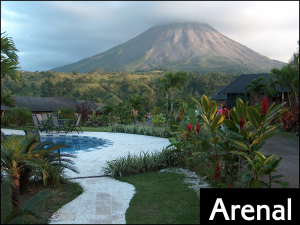 Another active volcano that is a well developed attraction is Arenal 90 kilometers north of San Jose. It last erupted in 1968 and destroyed the nearby town of Tabacon. It remains on the list of the world’s most active, though it remains subdued with regular venting, issuing vapors and gases through fumaroles and geysers.
Another active volcano that is a well developed attraction is Arenal 90 kilometers north of San Jose. It last erupted in 1968 and destroyed the nearby town of Tabacon. It remains on the list of the world’s most active, though it remains subdued with regular venting, issuing vapors and gases through fumaroles and geysers.
Tour and hotel operators have taken advantage of Arenal’s active but stable condition with many options for experiencing Arenal’s might including relaxing mineral hot springs. It has an altitude of 1,670 meters (5,479 feet). Lodging and tours to Arenal are easy to find.
Rincon de la Vieja Volcano in a national park of the same name is on Costa Rica’s northern Pacific side, 15 miles from the city of Liberia. This volcano is very active and the park is well developed with trails leading to boiling mud pools, fumaroles, geysers and hot springs. There are also lush, tropical cloud forests and beautiful waterfalls to be seen and experienced.
At an elevation of 1,916 meters (6,286 feet) Rincon de la Vieja is in the lower coastal range. Most hotels and travel agents in Liberia offer tours to Rincon de la Vieja Volcano National Park.
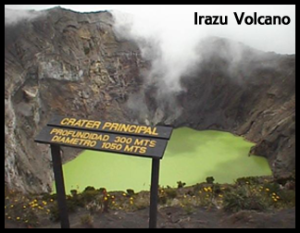 Near the city of Cartago, Irazu Volcano last erupted in 1994 and remains slightly active. Raising to 3,432 meters (11,260 feet) you can see both the Pacific and Caribbean coasts from the crater rim. Overnight tours are available from Cartago or San Jose.
Near the city of Cartago, Irazu Volcano last erupted in 1994 and remains slightly active. Raising to 3,432 meters (11,260 feet) you can see both the Pacific and Caribbean coasts from the crater rim. Overnight tours are available from Cartago or San Jose.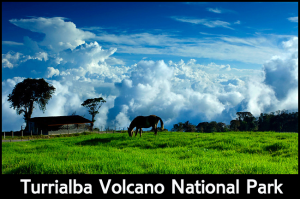
In Turrialba Volcano National Park you’ll find Turialba Volcano which rises to 3,340 meters (10,958 feet). It is near Irazu Volcano and shares lava tubes. It is more active than Irazu and of interest to volcanologists studying features formed by the last eruptions.
Andrew Kolasinski born in The Hague, arrived in Canada as a small child riding in the luggage rack of a DC-7. Since then he has felt at home anywhere. As the publisher and editor of Island Angler, Andrew spends half the year fishing for salmon and trout, and in the off-season he travels the world looking for a story. He wrote this article for South American Vacations, specialists in Costa Rica tours and travel all over Latin America.

